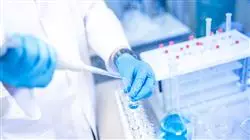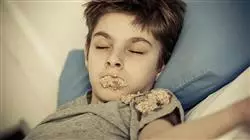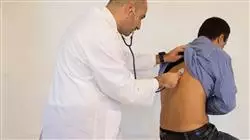University certificate
The world's largest faculty of nursing”
Description
Improve your knowledge in Forensic and Legal Nursing through this program, where you will find the best didactic material with real clinical cases. Learn here about the latest advances in Forensic and Legal Nursing in order to carry out quality work in this field”

This Professional master’s degree combines scientific application with the practical side, while at the same time adapting to new technologies with the implementation of online training. It allows the student to learn the basic principles necessary for the study of forensic thanatology, forensic pathology, forensic sexology, forensic toxicology, forensic psychiatry, damage assessment, anthropology, and criminalistics.
The Professional master’s degree meets the needs of professionals who demand adequate knowledge to enable them to carry out forensic assessments and expert reports, as well as the ability and fluency to ratify their opinion and understand the stages of the legal proceedings when necessary. At the same time, it offers the possibility for all students to learn how to assess not only bodily injury, but also to quantify negligence, assess disability, and determine disabilities.
Currently, law firms and private clients require a forensic expert examination for most of their procedures. It is for this reason, in addition to the lack of existing professionals, that we consider it appropriate to implement a correct, up-to-date, and especially useful syllabus for the daily practice of this activity.
The program is designed to provide online training equivalent to credits and 1,500 hours of study, and all theoretical and practical knowledge is presented through high quality multimedia content. Analysis of clinical cases is prepared by experts, with master classes and video techniques that allow the exchange of knowledge and experience. This course aims to maintain and update the skill level of its members, create protocols for action and disseminate the most important developments in the speciality. With online training, students can organize their time and pace of learning, adapting it to their schedules, in addition to being able to access the contents from any computer or mobile device.
Expand your knowledge through this Professional master’s degree program inForensic and Legal Nursing”
This Professional master’s degree in Forensic and Legal Nursing contains the most complete and up-to-date scientific program on the market. The most important features include:
- More than 75 clinical cases presented by experts in Forensic and Legal Nursing
- The graphic, schematic, and eminently practical contents with which they are created provide scientific and practical information on the disciplines that are essential for professional practice
- Latest innovations on the role of Forensic and Legal Nursing
- It contains practical exercises where the self-evaluation process can be carried out to improve learning
- Algorithm-based interactive learning system for decision-making in the situations that are presented to the student
- With special emphasis on evidence-based nursing and research methodologies in Forensic and Legal Nursing
- All this will be complemented by theoretical lessons, questions to the expert, debate forums on controversial topics, and individual reflection assignments
- Content that is accessible from any fixed or portable device with an Internet connection
This Professional master’s degree may be the best investment you can make when choosing a refresher program for two reasons: In addition to updating your knowledge in Forensic and Legal Nursing, you will obtain a qualification from TECH Global University"
The teaching staff includes professionals from the field of Forensic and Legal Nursing, who bring their experience to this training program, as well as renowned specialists from leading scientific societies.
The multimedia content, developed with the latest educational technology, will provide the professional with situated and contextual learning, i.e., a simulated environment that will provide an immersive training program designed to train in real situations.
This program is designed around Problem Based Learning, whereby the professional must try to solve the different professional practice situations that arise during the program. For this purpose, the physician will be assisted by an innovative interactive video system created by renowned and experienced experts in the field of Forensic and Legal Nursing with extensive teaching experience.
Increase your decision-making confidence by updating your knowledge through this Professional master’s degree"

Make the most of the opportunity to learn about the latest advances in Forensic and Legal Nursing and improve your patient care"
Syllabus
The structure of the contents has been designed by a team of professionals from the best hospitals and universities in the country, who are aware of the relevance of up-to-date training in the field, and are committed to quality teaching through new educational technologies.

This Professional master’s degree in Forensic and Legal Nursing contains the most complete and up-to-date scientific program on the market”
Module 1. Introduction to Forensic Nursing
1.1. Identifying Injuries
1.1.1. Concept of the Problem
1.1.2. Methodology
1.1.3. Legal Applications of Expert Evidence
1.2. Role of Forensic Nurses
1.2.1. Simulation
1.2.1.1. Detection
1.2.1.2. Simulation vs. Factitious Disorders
1.2.2. Dissimulation
1.2.2.1. Detection
1.2.3. Syndromes
1.2.3.1. Münchhausen Syndrome
1.2.3.2. Münchhausen Syndrome by Proxy
1.2.3.3. Medea Syndrome
1.3. Phytotoxicology
1.3.1. Introduction
1.3.2. Drug Intoxications
1.3.3. General Phytotoxicology
1.4. Forensic Evidence Collection in Nursing
1.4.1. Evidence Collection
1.4.1.1. Blood
1.4.1.2. Semen
1.4.1.3. Hair
1.4.1.4. Pollen
1.4.1.5. Exudates (Other Samples)
1.4.2. Storage and Transport of Samples
1.4.2.1. Chain of Custody Concept
1.4.2.2. Documentation
1.4.2.2.1. Assessment Sheet
1.4.2.2.2. Functional Patterns
1.4.2.2.3. Needs
1.4.2.2.4. Nurse’s Report
Module 2. Forensic Thanatology
2.1. Forensic Thanatology
2.1.1. Concept and Content
2.1.2. Concepts of Death
2.1.3. Degrees of Death
2.2. Different Ways of Dying
2.3. Course and Speed of Death
2.3.1. Signs of Agony
2.3.2. Precedence in Multiple Deaths
2.4. Diagnosis of Death
2.4.1. Concept and Methodology
2.5. Death Demonstrated
2.5.1. Encephalic Death
2.5.2. Death in Cardiac Arrest
2.6. Cadaveric Phenomena
2.6.1. Concept
2.6.2. Classification
2.7. Cooling
2.7.1. Production Mechanism
2.8. Dehydration, Lividity, and Hypostasis
2.8.1. Production Mechanism
2.9. Stiffness and Spasm
2.9.1. Production Mechanism
2.10. Autolysis and Putrefaction
2.10.1. Chronology of Putrefaction
2.11. Preservative and Transformative Phenomena of the Cadaver Saponification
2.11.1. Concept and Classification
2.12. Preservative and Transformative Phenomena of the Cadaver. Mummification
2.12.1. Concept
2.12.2. Phases of the Process
2.13. Preservative and Transformative Phenomena of the Cadaver Corification
2.13.1. Concept
2.13.2. Phases of the Process
2.14. Other Cadaveric Phenomena
2.14.1. Concept
2.14.2. Phases
2.15. Duration of Death
2.15.1. Concept and Importance
2.15.2. Routines and Means of Dating Death
2.16. Criminal Judicial Autopsy and Civil Judicial Autopsy
2.16.1. Definition and Methodology
2.16.2. Forms of Action
2.17. Autopsy Times
2.17.1. External Cadaveric Examination
2.17.2. Internal Cadaveric Examination
2.18. Auxiliary Techniques for Forensic Medical Necrodiagnosis
2.18.1. Classification and Concept
2.19. Vital, Perimortal, and Postvital injuries
2.19.1. Origin
2.19.2. Routines
2.19.3. Diagnostic Methods
2.20. Discovery of the Corpse
2.20.1. Removal of the Corpse
2.20.2. Site Inspection
Module 3. Forensic Pathology I
3.1. Mechanisms of Death in the Injuries
3.1.1. Classification
3.1.2. Destruction of Vital Centers
3.1.3. Hemorrhage
3.2. Diagnosis of Death by Traumatic Shock or Embolism
3.2.1. Concept
3.2.2. Production Mechanism
3.3. Multiorgan Dysfunction Syndrome
3.3.1. Definition and Concept
3.4. Mechanisms of Natural Death
3.4.1. Concept and Classification
3.5. Natural Death of Cardiovascular and Respiratory Origin
3.5.1. Concept and Classification
3.6. Natural Death of Neurological Origin
3.6.1. Concept and Diagnosis
3.7. Natural Death of Digestive and Metabolic Origin
3.8. Sudden Infant Death
3.8.1. Classification
3.8.2. Possible Disguised Deaths (Abuse)
3.9. Sudden Adult Death
3.9.1. Concept and Classification
3.10. Study of Contusions
3.10.1. Signs of Struggle
3.10.2. Signs of Defence
3.11. Stab Wounds
3.11.1. Types of Wounds
3.11.2. Production Mechanism
3.12. Gunshot Wounds
3.12.1. Types of Wounds
3.12.1.1. Entry Wounds
3.12.1.2. Exit Wounds
3.12.1.3. The Way They Are Formed
3.13. Electrical Injuries
3.13.1. Concept
3.13.2. Production Mechanism
3.14. Cold, Radiation, and Atmospheric Pressure Injuries
3.14.1. Concept
3.14.2. Classification
3.14.3. The way they are formed
3.15. Heat Injuries and Burns
3.15.1. Concept
3.15.2. Classification
3.15.3. Identification
3.16. Fire Injuries
3.16.1. Concept
3.16.2 Classification
3.16.3. Identification
3.17. Blast Injuries
3.18. Major Disasters
Module 4. Forensic Pathology II
4.1. Domestic Abuse
4.1.1. Concept
4.1.2. Detection
4.1.3. Diagnosis
4.2. Child Abuse
4.2.1. Concept
4.2.2. Detection
4.2.3. Diagnosis
4.3. Child Sexual Abuse
4.3.1. Concept
4.3.2. Detection
4.3.3. Diagnosis
4.4. Abuse in Relationships
4.4.1. Concept
4.4.2. Detection
4.4.3. Diagnosis
4.4.4. Possible False Abuse
4.5. Elder Abuse
4.5.1. Concept
4.5.2. Detection
4.5.3. Diagnosis
4.6. Traffic Accident Injuries
4.6.1. Concept
4.6.2. Classification
4.7. Forensic Medical Investigation of Aircraft Accidents
4.7.1. Concept
4.7.2. Basic Notions
4.8. Mechanical Asphyxiation
4.8.1. Concept
4.8.2. Classification
4.9. Mechanisms of Death
4.9.1. Common Injuries in Deaths Due to Asphyxiation
4.10. Hanging
4.10.1. Concept
4.10.2. Classification
4.10.3. Diagnosis
4.11. Strangulation
4.11.1. Concept
4.11.2. Classification
4.11.3. Diagnosis
4.12. Suffocation
4.12.1. Concept
4.12.2. Diagnosis
4.13. Submersion
4.13.1. Concept
4.13.2. Diagnosis
4.14. Violent Infant Death
4.14.1. Concept
4.14.2. Relevant Aspects to Identify Possible Attacks
4.15. Natural and Violent Pathology in Relation to Work
4.15.1. Common Disease
4.15.2. Occupational Disease
4.15.3. Work-Related Disease
4.15.4. Common Accidents
4.15.5. Occupational Accidents
4.16. Causal Links in the Production of Injuries
4.17. Contents of the Medical Report to Aid the Courts
Module 5. Forensic Sexology
5.1. Crimes Against Sexual Freedom and Indemnity
5.1.1. Concept
5.1.2. Classification
5.2. Pregnancy and Abortion
5.2.1. Concept
5.2.2. Typology
5.2.3. Issues of Interest to the Courts
5.3. Physiological Birth Diagnosis
5.3.1. Concept
5.3.2. Issues of Interest to the Courts
5.4. Sex Diagnosis
5.4.1. Concept
5.4.2. Issues of Interest to the Courts
5.4.3. Update on Gender Dysphoria
5.5. Sexual Dysfunctions
5.5.1. Concept
5.5.2. Classification
Module 6. Forensic Toxicology
6..1. Introduction
6.1.1. Etiology
6.1.2. Mechanisms
6.2. Gas and Vapor Poisoning
6.2.1. Concept
6.2.2. Classification
6.2.3. Diagnosis
6.3. Poisoning by Caustics, Metals, and Derivatives
6.3.1. Concept
6.3.2. Classification
6.3.3. Diagnosis
6.4. Alcohol and Solvent Poisoning
6.4.1. Concept
6.4.2. Classification
6.4.3. Diagnosis
6.5. Pesticide Poisoning
6.5.1. Concept
6.5.2. Classification
6.5.3. Diagnosis
6.6. Drug, Food, Mushroom, and Venom Poisoning
6.6.1. Concept
6.6.2. Classification
6.6.3. Diagnosis
6.7. Autopsies in Poisoning Deaths
6.7.1. Concept
6.7.2. Etiology
6.7.3. Classification
Module 7. Critical Care in Patients with Other Pathologies
7.1. Concept
7.1.1. Objectives
7.1.2. Application
7.2. Imputability
7.2.1. Aspects of Legal Interest
7.2.2. Criminal Law Concepts
7.3. Capacity to Act
7.3.1. Personal Training
7.3.2. Influence of External Agents
7.4. Medical - Forensic Aspects of Developmental Disorders
7.5. Medical - Forensic Aspects of Delirium
7.5.1. Dementia
7.5.2. Amnesia
7.5.3. Other Cognitive Disorders
7.6. Medical - Forensic Aspects of Alcohol-Related Disorders
7.6.1. Alcohol Poisoning
7.6.2. The Influence of Alcohol in the Blood
7.7. Medical - Forensic Aspects of Cocaine and Opiate-Related Disorders
7.7.1. Legal Considerations on Consumption
7.7.2. Identification
7.7.3. Influence on the Subject
7.8. Medical - Forensic Aspects of Cannabis and Other Drug-Related
7.8.1. Legal Considerations on Consumption
7.8.2. Identification
7.8.3. Influence on the Subject
7.9. Medical - Forensic Aspects of Psychotic Disorders
7.9.1. Schizophrenia
7.10. Medical - Forensic Aspects of Psychotic Disorders
7.10.1. Delusional Disorder
7.11. Medical - Forensic Aspects of Mood Disorders
7.11.1. Classification
7.11.2. Diagnosis
7.12. Medical - Forensic Aspects of Anxiety Disorders
7.12.1. Post-Traumatic Stress Disorder
7.13. Medical - Forensic Aspects of Somatoform Disorders
7.13.1. Classification
7.13.2. Diagnosis
7.14. Medical - Forensic Aspects of Sexual Orientation Disorders
7.14.1. Classification
7.14.2. Diagnosis
7.15. Medical - Forensic Aspects of Impulse Control Disorders
7.15.1. Classification
7.15.2. Diagnosis
7.16. Medical - Forensic Aspects of Personality Disorders 1
7.16.1. Classification
7.16.2. Diagnosis
7.17. Medical - Forensic Aspects of Personality Disorders 2
7.17.1. Classification
7.17.2. Diagnosis
Module 8. Forensic Anthropology
8.1. Introduction
8.1.1. Concepts
8.2. Anthropological Analysis
8.2.1. Methodology
8.2.2. Development
8.2.3. Classification
8.3. Determining Certain Aspects of the Subject
8.3.1. Age
8.3.2. Sex
8.3.3. Size
8.4. Dental Identification
8.4.1. Dental Concepts in Children
8.4.2. Dental Concepts in Adults
8.4.3. Classification of Dental Pieces
8.5. Taphonomy
8.5.1. Cadaver-Environment Relationship
8.5.2. Data of the Remains
Module 9. Criminology
9.1. Identification in Criminology
9.1.1. Identification of People
9.1.2. Identification of Recent and Old Corpses and Remains
9.1.3. Identification from Clues
9.2. The Study of Prints
9.2.1. Zuckerman
9.2.2. Eysenck
9.2.3. Cloninger
9.3. Bloodstain Investigation
9.3.1. Social Personality
9.3.2. Deviant Personality
9.3.3. Antisocial Personality
9.4. Other Biological Stains
9.4.1. Egocentric Individuals
9.4.2. Aggressive Individuals
9.4.3. Lability
9.4.4. Affective Indifference
9.5. Forensic Genetics
9.5.1. Origin of Criminology
9.5.1.1. Definitions of Interest
9.5.2. Criminology of Personality
9.5.2.1. Concept
9.5.3. Clinical Criminology
9.5.3.1. Concept
9.5.4. Criminology of Development
9.5.4.1. Concept
9.5.5. Levels of Interpretation
9.5.5.1. Behavioral Level
9.5.5.2. Individual Level
9.5.5.3. General Level

A unique, key, and decisive training experience to boost your professional development”
Professional Master's Degree in Forensic and Legal Nursing
Ever since the scholar Leonardo Da Vinci made his first anatomical drawings examining the dead, postmortem studies have been a significant resource, not only for the medical sciences but also for the justice system itself. The angle of a break in a bone, a change of coloration in saliva or the heterogeneous distribution of a substance in a tissue can become clues that lead to the apprehension or exoneration of someone. If you are interested in the world of criminalistics, this is your opportunity to give an innovative approach to your career. The Professional Master's Degree in Forensic and Legal Nursing is a program developed by TECH Global University that seeks to incorporate in the canon of studies of healthcare personnel, skills applied to the field of forensic forensics and thanatology. We provide 100% online classes and a faculty with extensive experience in the sector that will address numerous clinical cases in a highly immersive simulated environment. Do you want to go a step further in your professional life? At TECH we have what you are looking for.
Become a Forensic Nurse Practitioner
Sherlock Holmes, the popular detective created by the writer Arthur Conan Doyle, is one of the great references in fiction to be passionate about criminal investigation. It is this character who in one of his lines argued: "Always look for a possible alternative and be prepared for it". The postgraduate program that we offer you is the option you should adopt if you wish to enrich your nursing curriculum and excel with skills of remarkable professionalism. Some of these, which you will find throughout the content are: identification of injuries, sample collection, auxiliary techniques for necrodiagnosis, cadaveric phenomena, toxicology, sexology, forensic psychiatry, anthropology, study of fingerprints, among others. Rarely will you find such a complete educational program that gives you the opportunity to specialize in an online educational environment with the highest scientific and technological standards. Criminalistics and nursing, a fascinating duo that will fulfill your expectations and will open the doors to a better working world.







